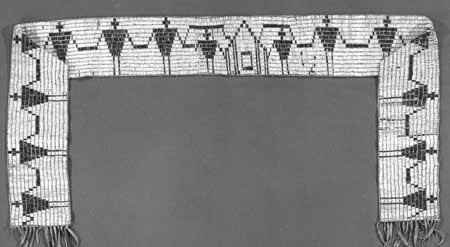Cultural Context
Rene Descartes introduced the idea of a two-axis system for geometry in 1637, and Cartesian coordinates are named in his honor. But long before then, the Indigenous People of North and South America were using a similar concept. They saw the idea of four directions as more than just mapping: it was a sacred organizing principle. It could be used in everything from a prayer ceremony to village architecture to things for everyday use like a woven blanket.

The traditional bead loom is a great way for students to learn how Indigenous mathematical and computational ideas can be found in these designs. The bead loom is laid out much like a Cartesian coordinate system. We have beads in rows and columns: which is the X axis and which is the Y axis? If Europeans had never come to North America, what names would we associate with "X axis" and "Y axis"?
Four-Fold Symmetry
Below are four images of Native American designs. How would you describe them in terms of geometry? What geometric features do they all have in common? Write down your answers, and compare it to your neighbors.
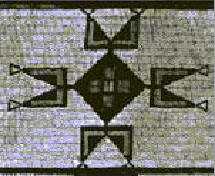
Embroidery, Plains Indians
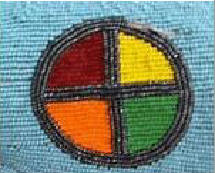
Shoshone “show-SHOW-nee” Beadwork
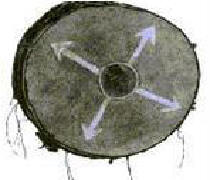
Pawnee “PAW-nee” Buffalo Hide Drum

Navajo “NAV-uh-hoe” rug
Many animals have bodies in which the right half is the mirror image of the left half. That is called "reflection symmetry." Some things have reflection symmetry between top and bottom. Footballs and soup cans, for example, have one shape that is the same for top and bottom, and a different shape that is the same for left and right. If you have the same shape reflected in four directions, it is called four-fold symmetry. If we ignore some details like the color differences in the beadwork example, then all of these designs can be described as having four-fold symmetry. Four-fold symmetry is a deep design theme in many Native American cultures. It is used as an organizing principle for religion, society, and Native technology. Many Native languages, for example, use base four counting. Teepees are often made with four base poles, each placed in one of the four directions. Prayers are often offered to "the four winds."
Navajo
Navajo sand painting offers many good examples of four-fold symmetry. These are used in healing ceremonies. A medicine man ("hataalii") completes the drawing in one day, using colored powder such as crushed stone. The painting is brushed away later that night, along with the illness.

Navajo rug based on a sand painting
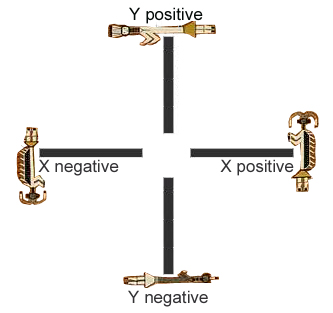
Cartesian Graph
+X = Right-side up figure with backpack
-X = Upside-down figure with backpack
+Y = White straight figure
-Y = Dark straight figure
In the Navajo religion, the hataalii heals through the balance of forces. Sand paintings often use reflection symmetry to show these paired forces. Some of these structures are similar to a Cartesian graph. Navajo tradition does not permit photos of sand paintings, so at left we have shown a Navajo rug based on a sand painting. Here we see four human figures. Figures on the horizontal axis are hunched over with back packs. Those on the vertical axis have straight backs.
Yupik
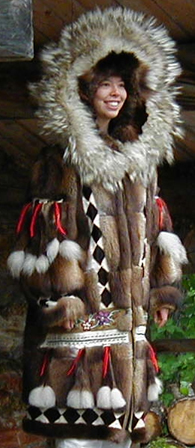
Another example in which native design is similar to the Cartesian coordinate system is in Yupik parka decoration. According to Claudette Bradley, professor of education at University of Alaska, the Yupik ("YOU-pick") say it is important to have both sides looking exactly the same (reflection symmetry again!). So they developed a coordinate system, measuring vertical and horizontal distance on the parka using the width of two fingers as the unit of length. The center of the coordinate system is near the belly button. Why might that be?
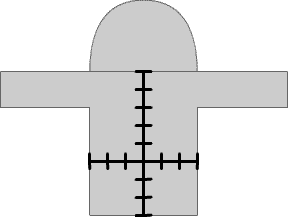
Iroquois
Native American beadwork was created before Europeans arrived. Here we see a loom that was used to create wampum belts. Wampum beadwork was often used to record messages and historic events. This belt was presented by the U.S. government to the Iroquois ("EAR-uh-kwoy") in 1794 at the Pickering Treaty. The house at center, with one small figure on each side, represents the Iroquois. The large human figures represent the US. How many (counting those in the folds), and why that number? They form a chain of friendship between the US and the Iroquois confederacy. The Iroquois confederacy was an important influence on the founders of the US constitution. In 1751, Benjamin Franklin tried to shame the colonists into forming a union by saying, "It would be a strange thing... if Six Nations of [indians] should be capable of forming such a union... and yet that a like union should be impractical for ten or a dozen English colonies...".

